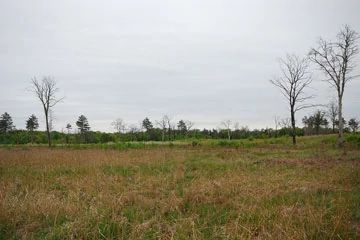Necedah Oak-Pine Savanna
No. 7

Photo by Josh Mayer
Necedah Oak-Pine Savanna, once part of Glacial Lake Wisconsin, is flat to slightly rolling plain. Soils are Newton and Morocco sands without a diagnostic subsurface horizon and Au Gres sands formed over acid sands. The presettlement vegetation of this area was jack pine and oak barrens. The site has some barrens openings but is mostly a closed forest of jack pine and Hill's oak. Within the openings are numerous prairie and barren species including big and little blue-stem, Indian grass, rough blazing star, wild lupine, and large patches of blueberries.
Nesting birds are typical barrens-dry forest species including eastern bluebird, vesper, field and chipping sparrows, blue jays, rose-breasted grosbeak, rufous-sided towhee, ovenbird, and crested flycatcher. The area was originally established to restore pine barrens and as a comparison for the adjacent unburned forest. Management activities include controlled burning and brush removal to maintain savanna conditions. Necedah Oak-Pine Savanna is owned by the U.S. Fish and Wildlife Service and was designated a State Natural Area in 1966.
Very few State Natural Areas have public facilities, but nearly all are open for a variety of recreational activities as indicated below. Generally, there are no picnic areas, restrooms, or other developments. Parking lots or designated parking areas are noted on individual SNA pages and maps. If a developed trail is present, it will normally be noted on the SNA map and/or under the Maps tab. A compass and topographic map or a GPS unit are useful tools for exploring larger, isolated SNAs.
The good majority of SNAs are isolated and have few or no facilities. Some SNAs have vehicle access lanes or parking lots, but their accessibility may vary depending on weather conditions. Parking lots and lanes are not plowed during winter. Hiking trails may be nonexistent or consist of undeveloped footpaths. A GPS unit or compass and a detailed topographic map are useful tools for exploring larger SNAs.
Non-DNR lands
Entrance fees: For non-DNR-owned SNAs, we are unaware of any vehicle or admission fees. However, please contact the landowner for more information.
Hunting and trapping
Other activities
Other allowable activities such as - but not limited to camping, geocaching and bicycling are determined by the landowner. Please contact them directly or visit their websites for details.
Location
Within the Necedah National Wildlife Refuge, Juneau County. T19N-R2E, Section 12. 239 acres.
Driving directions
From the intersection of Highway 80 and 12th Avenue in Sprague, go west on 12th Avenue for 0.1 miles, then south and west on 9th Street West for 3.3 miles, then south on 12th Street West for 0.25 miles to the northeast corner.
The DNR's state natural areas program is comprised of lands owned by the state, private conservation organizations, municipalities, other governmental agencies, educational institutions and private individuals. While the majority of SNAs are open to the public, access may vary according to individual ownership policies. Public use restrictions may apply due to public safety, or to protect endangered or threatened species or unique natural features. Lands may be temporarily closed due to specific management activities.
Users are encouraged to contact the landowner for more specific details. The data shown on these maps have been obtained from various sources, and are of varying age, reliability, and resolution. The data may contain errors or omissions and should not be interpreted as a legal representation of legal ownership boundaries. To create your custom map where you can zoom to a specific location, please use the DNR's Mapping Application.
Necedah Oak-Pine Savanna is owned by: U.S. Fish and Wildlife Service
